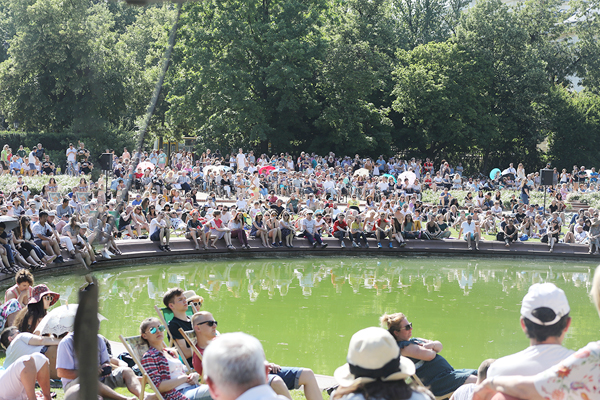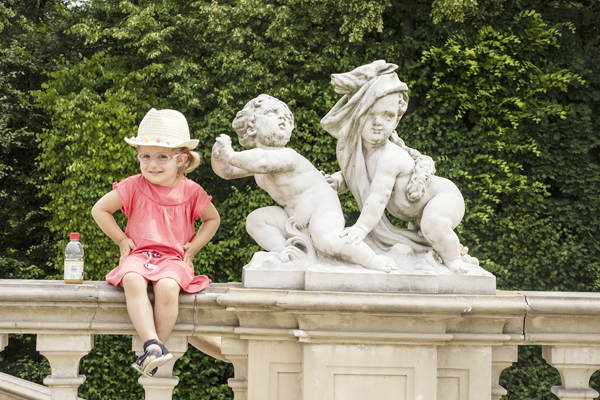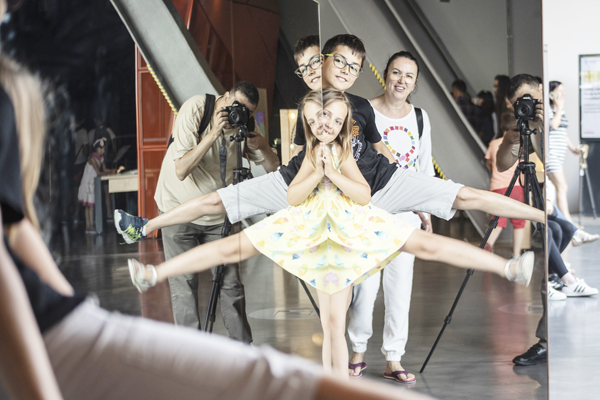Why Warsaw? For many reasons. First, after many years of work the rebuilding of the ancient Citadel and gardens, fully funded by the people of the city, has been completed. Second, on 1 August at 5pm every year life stops in Warsaw to commemorate the city’s war-time uprising against the Nazi occupation, and this year marks the 75th anniversary.
Third, Warsaw is home to many castles we may know little about in Egypt and innovative multimedia museums. Al-Azhar in Cairo recently called on Polish consultants when designing its internal lighting system, for example. Fourth, Warsaw has a theatre where I watched a play called Pilots that used technology that words alone cannot possibly explain. An airplane seemed to explode after being hit by a missile and the entire audience jumped up in terror. Then the pilot seemed to eject out of the blazing ball and parachute down onto the stage.
Finally, the people are friendly and straightforward, and prices are cheaper than in other EU countries.

The old town
I landed at Chopin Airport in Warsaw and rediscovered that Warsaw residents, like those in Belgrade, Budapest and elsewhere, strongly dislike being referred to as “Eastern European” when they are actually in Central Europe. I have now visited Warsaw several times at different times of the year, and last spring I went to the house where the composer Fryderyk Chopin was born in the village of Żelazowa Wola some 45km west of the city.
The house is surrounded by gardens where the compositions of the great musician can be heard softly floating through the trees.
Although Chopin lived in Paris, he loved Poland so much that he asked that his heart be returned there after his death. There is now a museum in the heart of the city dedicated to the composer, and the Varsovians rebuilt his giant statue that was destroyed by the Nazis in World War II and returned it to the Royal Łazienki Park in 1958. Since 1959, two Chopin concerts have been held there every Sunday by the statue attended by thousands of classical music lovers.
The Łazienki Park is extensive, and it took me an hour to walk from the gates to the concert location. I strolled at a leisurely pace, taking pictures of the boats on the lake, the trees, statues, palaces, and so on. On the way out, I took more pictures and met with the pianist who had given the concert, who happened to be from Ukraine. Finally, I sat down in the Trou Madame Café to enjoy the weather, ate hot apple pie with vanilla ice cream on top, and paid 21 Polish złoty, or roughly $6.

The old town during Warsaw uprising (photo: Ewa Faryaszewska)
Warsaw is home to several royal castles, most notably the Wilanów Palace where the Polish king Jan III Sobieski lived. He is famous for defeating the Ottoman army during the Ottoman siege of Vienna in 1683, an event that is seen as a turning point after which the Ottoman Empire was unable any longer to threaten Europe. Although many view the battle as a decisive one in religious history, representing the idea of the Cross versus the Crescent, Sobieski himself viewed it as a political war.
He once stood in Eastern Poland in the province of Podlaskie Voivodeship where his Muslim Tatar subjects lived, raised his sword, and said “in the name of the Father, the Son and the Holy Ghost, I inaugurate this mosque”. As a result, the first mosque in Poland, and perhaps in all of Central Europe, was built after the Christian blessing of the Trinity.
Sobieski’s gorgeous Palace is built in Baroque style and is known as “Poland’s Versailles”, As well as its luxurious architecture, there are vast flower gardens surrounding it. I have visited the Palace three times over five years, and every time I return, I find a new section has been added or removed from the tour because of the constant renovation.

Warsaw library
Perhaps the most distinctive feature of the Palace is that it was the home to one of the most extraordinary love stories in European history between Sobieski and his French-born wife Maria Kazimiera d’Arquien, whom he addressed by the diminutive form of Marysieńka. It is a story told through the letters they wrote to each other during his travels to fight outside Vienna and elsewhere.
VISITING THE PALACE
On my last trip, I was fortunate enough to be accompanied by a brilliant guide and companion, Łukasz Błaszczykiewicz ,who told me that Sobieski had built the Wilanów Palace in stages because of a lack of funds and to avoid objections by the nobility who criticised him for buying up private property to build it.
This was thought to contradict the country’s constitution, which prohibited Polish royalty, who were elected, from buying up landed estates. Poland’s was the first constitution in Europe and the second in the world. However, Sobieski resorted to a clever ruse and signed a contract with an architect friend dated seven years before he was elected king. The idea of electing the monarch is a tale for another day.
After visiting the Wilanów Palace and walking around its grounds, I stopped for a quick bite to eat and a drink. I found the Złoty Król pub by the gates, a great choice. This is a pleasant restaurant where an older gentleman called Tom sits and does not like to talk, but I was able to cajole him into showing me pictures of his restaurant after World War II.

Łazienki Park
My guide knew exactly what I needed as a photographer and insisted that we first go to the library of Warsaw University. I told him that I didn’t want to waste time visiting a library when there was so much else to do in Poland, but he explained that this was a library like none other. Indeed, it was an amazing opportunity to take photographs of the city, and I ended up asking for more time on the roof. He had been begging me to hurry as we had an appointment at a royal castle in the Old Town.
Shortly before travelling to Warsaw for the first time eight years ago, I read that the Old Town was built after the end of the War. I honestly didn’t know why I should visit this modern area and why it was called the “Old Town”.
I shared my thoughts with Warsaw resident Dorota Bobecka, who has pure Polish blood running through her veins. As she drove her car around the town, she pointed to an old church and said she had been baptised there; before the church was built, there had stood one of the most notorious Nazi prisons where her grandfather had been imprisoned, she added.
She told me the story of her grandfather, Władysław Kraśnicki, who had owned a large transportation company and had been a member of the Polish resistance, the Armia Krajowa (Home Army), against the Nazis.
On one occasion, her grandfather had been smuggling fighters in a truck and had realised he was fast approaching an unexpected roadblock, so he slowed down and shouted to his cargo to jump out. They jumped out and hid in the surrounding forest, but one of them had foolishly decided to hide his gun in the truck. The Germans searched the truck, the gun was found, and Kraśnicki was arrested and sent to a Nazi camp.
However, his knowledge of cars saved his life and he was not killed. A German officer took pity on him, and he was allowed to keep a picture of his wife, nanny and two daughters instead of being tortured.

Łazienki Park
Bobecka took me to the Warsaw Uprising Museum, a multimedia museum where I watched a film about the history of Warsaw that many people in Egypt may know little about. In August 1944, the residents of the city made a deal with the former Soviet Union to rise up against the Nazis. The uprising lasted two months, but unfortunately the Soviet forces did not keep their side of the bargain and stood by without lifting a finger.
Hitler was greatly angered by the uprising, and the whole of Warsaw was systematically blown up by the German army and erased from the face of the earth, including the old Cathedral and Citadel. All that remained was one church, which was not demolished for the simple reason that it stood between the Soviet and German troops.
As soon as the War was over, and although Poland fell under Communist rule and most of Warsaw was rebuilt in a typically ugly Soviet form, the residents of Warsaw went to work to rebuild their city. The Old Town was meticulously rebuilt using the method of anastylosis, in which the original bricks were reused as much as possible. Thus, like the mythical phoenix, Warsaw rose up from the ashes.

Willanow Palace
Although the Royal Castle, some parts of which dated back to the mid-14th century, had throughout history been the target of looting or demolition, what Hitler and his soldiers did was beyond imagination. Once the uprising began, the castle’s staff attempted to save their country’s national treasures and succeeded in hiding some of them, such as paintings by the 17th-century Dutch painter Rembrandt, an antique clock featuring Father Time, and others.
But other pieces were not as fortunate and were taken by the Germans. The entire conference hall was taken by the Nazis, who went on to destroy the castle.
After the War, the new Communist government attempted to rebuild the castle, but in the end the Polish people, poor and rich, and living in Warsaw and overseas, rebuilt the Old Town. This year, they completed the rebuilding of the citadel, with the latest project being renovating the Royal Gardens.
On 1 August at 3pm, I sat down in the cafeteria overlooking the gardens to enjoy a large serving of ice cream and fruit. I went for a walk across the new town to enjoy the spectacle of remembering the martyrs of the Uprising. At exactly 5 pm, sirens sounded, and life came to a standstill.
Car-drivers stepped outside their cars, and everyone stood in their places for one minute of silence as they have done every year for 75 years to commemorate the uprising.

Willanow Palace
EU laws ban the publication of people’s images without their permission, and I know many photographers who have returned from trips to Europe and been unable to publish the pictures they have taken or to exhibit them because of these unusual laws.
It is even more difficult when a child is in the picture, since you have to ask for written parental permission before publishing a photograph. I wanted to take pictures of children at the Copernicus Science Centre in Warsaw, and my long-time friends Mikołaj and Kaja Bobska were able to save the day.
The centre is a miracle that delivers scientific information to children of two years and older. Gravity, biology, light, photography, computers and much more are packed into a few hours of visiting. After a thoroughly enjoyable tour, I realised that I was ignorant of some of the video-recording tricks that a five-year-old can learn visiting this treasure known as “Copernicus for Children”.
At the end of the tour, which was even more enjoyable for adults than children, we disagreed on where to eat, but ended up at the Polin Museum of the History of the Polish Jews, where we found the perfect meal to please both Egyptian and Polish tastes at a reasonable price. Unfortunately, I didn’t have time to tour this extraordinary museum this time round, though I had been there before.
Then, it was my turn to invite my Polish friends to a Middle Eastern meal. I could have chosen kebabs, or shawarma as we call it, at any of the restaurants around town owned by Turks, Pakistanis and Bangladeshis, all of which the Poles love.
But instead, I chose a Lebanese restaurant that has two locations in Warsaw called Le Cédre. It is as elegant as a classic Polish restaurant, which often looks like a sitting room in an elegant home, and as expected the restaurant provided excellent service. The only problem was the bill, but no matter.
After all this, I decided that Warsaw would be the best place for me to go for the Christmas holidays as well.
Short link: